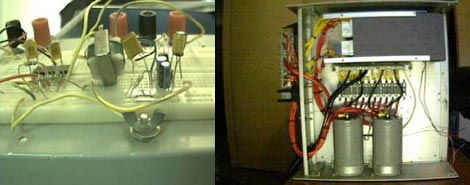
If you’re interested in learning about Very Low Frequency communications take a look at what Larry has to offer on his site. He’s put together a guide to VLF receivers that is short enough to read and clear enough to understand with rudimentary knowledge of circuits. He builds a simple receiver as a working example and a high-powered transmitter that can put out over 2600 watts. Let’s face it, radio operators were the original electronic hackers. Get back to our roots and learn the ways of the transistor.
[Thanks Buddy]















Really? Another transistor project? The guy could have done this with tubes.
Cool and next we can have a crystal radio that doesn’t use batteries soon?
Very cool stuff. I was looking for links to listen. There used to be a NASA site that lets you listen live to a VLF receiver. You can hear lightning happening anywhere on the globe, along with other earth related phenomenon. I think the sounds are called “tweaks and spherics” – youtube search seems to confirm this. very interesting!
You can also tune to VLF time reference stations and listen to beat frequencies (you can also write a decoder that will retrieve time, but that’s unnecessary, listening is cool enough).
@Chango Way to troll the trolls :-)
But seriously, this is some really good knowledge to get out there. I wonder how many people really understand the basics anymore?
This is cool. I’ve been looking for a way to go “low and slow” for awhile.
“Get back to our roots and learn the ways of the transistor.”
Or you could grow a pair and stop considering beginner projects hacks and give attention to quality projects.
As a ham radio operator, I love the small recent surge in radio hacks.
I also live in the same city as this guy. Cool.
You need to tune to 8 Hz to here the snaps and pops of lightning from around the world.
Yes, I meant hear and not here.lol
HAARP? The U.S. Military is doing similar research. Maybe I’m wrong on this one.
“radio operators were the original electronic hackers”
No love for telegraph operators? Thomas Alva, save us!
regulatre-
You may want to check out the World Wide Lightning Locator Network (wwlln.net). They
use a global network of VLF receivers to triangulate lightning strikes.
I just got my technician license for HAM radio, so I’m not the savviest person in the hobby; however, I do believe transmitting over 1500W is against FCC standards just to let anyone out there know that this device you build may piss some people off.
Finally analog radio post on HaD, I like this stuff so much
LOVING the radio stuff on here lately.
Every once in a while you read a story about some ham, (usually out west where there’s still some elbow room)that went to the trouble to string a quarter-wave radiator or some other kind of cool VLF array.
Great stuff HAD.
Radio isn’t dead, it’s just gone so mainstream that you don’t notice it’s in your pocket.
@Noxilenticus: Unless I’m mistaken, the VLF band doesn’t fall within the regulations of your amateur license. According to Wikipedia:
“The frequency range below 9 kHz is not allocated by the International Telecommunication Union and may be used in some nations license-free.”
Fill your boots.
@Alchemyguy
No need to be rude, you can’t blame the guy for not knowing everything.
It still is 2600 Watts.
although quite unreliable for anything else than listening to storms, it still is a nice analog project!
Can you confirm this that VLF Radio Receivers below 1 KHz range can listen to human conversations and can be used as spying devices to spy on neighbours. In particular, 80 Hz to 280 Hz range can be used to listen to neighbours as eavesdropping device. And it can even listen to whispers and heartbeat.
@Icarus: The challenge of text communications is that tone isn’t transmitted, barring emoticons. Try it again with a big old :D at the end. ;D